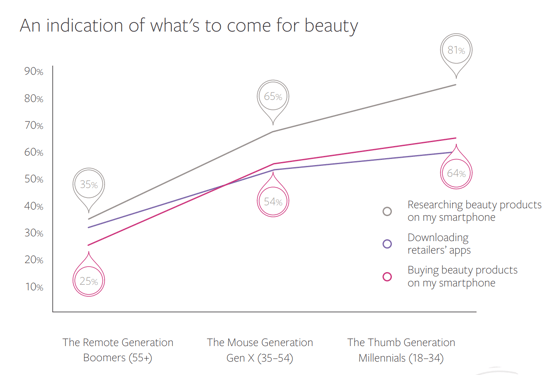
The Role of Mobile in the Beauty Industry
With mobile becoming indispensable and our amplified desire to be constantly connected, it’s no wonder that the ‘mobile-only’ generation is on the rise. Its role as the force at the center of our digital universe is only growing stronger.
Thanks to our smartphones, we're living in a world in which a mobile command center sits in the palm of our hands. As of 2019, the active number of global mobile social media population worldwide is 3.5 billion, equaling a 42% penetration rate.
Mobile has given us the opportunity to capitalize on very important, highly personal and uniquely relevant moments which are important to the Thumb Generation. These moments form part of their shopping journey to discover, evaluate and purchase a particular product or service via mobile.
By understanding more about moments that matter to people, brands have a wealth of opportunity to reach and engage with shoppers for a more personalized experience.
What Does This Mean for the Beauty Industry?
45% of beauty shoppers agree that their mobile device is becoming their most important shopping tool. Unsurprisingly, this percentage increases by 10% for millennials. 63% of beauty buyers say their mobile device is a resource for them to find information about products while shopping in-store.
In other words, mobile phones are being perceived as the new beauty counter because it unlocks an ever-evolving world of tailored resources that beauty shoppers crave for at their fingertips.
There are five major trends that global beauty brands should be cognizant about which illustrates the role of mobile in the consumer journey.
1. There is a significant shift from desktop to mobile for beauty buyers
55% of beauty buyers reach for their mobile devices first when they want to see beauty content. (Tweet this!)
Another 54% of them say that their mobile devices are more convenient than TV, magazines or desktop when it comes to exploring beauty related tutorials, product information, blogs and recommendations.
Ignoring significant points like these which highlights the importance of mobile would mean missing out on building a relationship with some of the industry’s most active buyers.
Our deep-rooted connection with our mobile devices is more personal and constant than our relationship with larger screens. This poses both opportunities and challenges for beauty marketers.
Recently, Facebook commissioned SalesBrain, a neuromarketing agency, to understand how our brain and physiology respond to identical media viewed on a smartphone versus a TV. There were three surprising key findings which stood out: mobile is bigger than we think; mobile is less distracting and mobile elicits positive feelings.
However, there are still some persistent friction points which exist on mobile devices.
.png?width=600&name=Copy%20of%20FB%20content%20layouts%20(2).png)
More than one in three US shoppers surveyed said that they would like to shop on their smartphones more. But one in two say poor navigation or slow load times are a barrier.
In a world where screen real estate is shrinking, the small screen needs to work harder to eliminate such friction points. (Tweet this!)
Slowly but surely, advertisers are realizing that solving their customers’ problems during the purchase journey unlocks more value for them.
Facebook has identified a $325 billion opportunity to create a Zero Friction Future for businesses. This aims to help businesses understand the full impact of friction during purchase journeys and how to manage it so that they may unlock new avenues for further growth. What does this mean for the beauty industry? 64% of beauty buyers predict that they will be buying more beauty products on their smartphones in the year ahead, so beauty brands need to stay ahead of the curve when it comes to being mobile-first.
Mobile’s role in the beauty path to purchase is only at its infancy stage and will continue to grow exponentially. (Tweet this!)

2. The rise of mobile content consumption means brands should understand how and what types of creative works on mobile
One way that beauty brands can meet the needs of these shoppers who have a huge reliance on their mobile devices is by embracing the Vertical Video Syndrome. With more than 94% of smartphone users now engaging with their devices vertically and 79% finding vertical videos more interesting, beauty brands should adapt their social media content to be mobile first. (Tweet this!) This means adopting vertical mobile formats for a more intimate, immersive and distraction free viewing experience.
Besides that, in a Facebook IQ-commissioned survey by Ipsos, 62% of people said they became more interested in a brand or product after seeing it in a Story. With Facebook Stories acting as an additional placement to News Feed or Instagram Stories ad campaigns, brands can utilize these platforms to reach and engage their audience on mobile through a full screen, immersive environment.
Since Instagram launched its Stories ads feature in January 2017, it has been taking over the advertising world by storm. Instagram reports that one third of the platform's most viewed Stories are from businesses. Brands that have not leveraged on engaging features such as Poll or Quiz, GIF stickers, Join Group and Questions Sticker stand to lose out on building an intimate connection with their followers.
Another reason for the proliferation of Stories for brands is the value of raw, real and uncut content in the eyes of followers which makes beauty brands approachable, genuine and likable. One way for beauty brands to capitalize on that is through the power of influencers who use Instagram Stories to conduct ‘Instagram takeovers’, ‘how-to’ tutorials, ‘behind-the-scenes’, ‘unboxing’ or ‘a day in the life of’ stories.
3. Increasing user preferences for messaging businesses directly means brands should start investing into Messenger more
The Facebook Messaging Survey reported that 53% of people are more likely to shop with a business they can message directly. As the world grows more mobile first, there is an increased expectation for businesses to be more responsive to their customers through Messenger.
Whether it’s through answering queries or responding to feedback, consumer expectation is rising – they want to engage with brands easily, quickly and at their convenience. (Tweet this!)
91% of consumers surveyed globally across eight markets say they're more likely to shop with brands who recognize, remember and provide them with relevant offers and recommendations. This further demonstrates that personalization in addition to quick responses by businesses can unlock meaningful connections with consumers who are interested in spending their money on the brand. (Tweet this!)
With over two billion messages being exchanged with over 20 million businesses each month on Messenger, there is an opportunity for brands to open up 1-to-1 conversations with their customer, stay on top of mind and tap into the ‘wallet effect’ where users can return to the conversation at any time.
4. Mobile devices are at the center of consumers’ complex omni-channel purchasing behavour
In today’s increasingly cross-device, omni-channel path to purchase, the only constant seems to be mobile. An omni-channel purchasing approach refers to a fully-integrated, seamless experience for the consumers whether shopping online from a desktop, mobile device, mobile, or brick-and-mortar store.
A once linear offline purchasing path now looks more complex, fluid and intertwined with the online world. 45% of all shopping journeys contain mobile, and for millennials, that number jumps to 57%.
42% of beauty buyers say most of the time, they go in-store to test beauty products in person, but eventually make the purchase online or on mobile. (Tweet this!)
While that trend may sound worrisome to some brands who don’t know how to anticipate this, the good news is that mobile devices are the unifying force across those journeys and are at the center of this complex omni-channel behavior.
As brand loyalty wanes and buying power increases, beauty brands need to prioritize the consumers’ mobile experience while shopping and not leave it as an afterthought to rise above the noise and stand out among an ever-growing competitive landscape. This is important to create a seamless brand ecosystem to further engage customers and nurture them along their buying journey.
5. Beauty brands should not underestimate the power of user reviews to build positive brand perception
Approximately 79% of beauty buyers who use their mobile phones while shopping in store are interested in user reviews.
From Gen Z to the Baby Boomers, we are a generation who is more accustomed to swiping and scrolling on our mobile phones compared to clicking on our desktop.
Negative reviews stop 40% of buyers from wanting to use a business and 86% of people will hesitate to purchase from a business that has negative online reviews.
Since comments and user reviews have more ‘screen real estate’ on vertical mobile screens compared to the desktops’ horizontal screens, this makes it easier for beauty buyers to ‘tap to expand’ and review the comment feed before making their purchases.
Therefore, beauty brands should not underestimate the power of user reviews and comments as it goes a long way in building positive brand sentiment on social media. Being able to identify and amplify positive feedback from fans via user-generated comments is important to build trust and positive brand perception. (Tweet this!)
Conversely, it takes roughly 40 positive customer experiences to undo the damage of a single negative review. Responding quickly by hiding or addressing harmful comments or attacks which may damage the brand perception is a necessary part of delivering excellent customer experience.
In summary, there are opportunities and challenges to expect in the shift from big screen to small screen
Thanks to mobile, people are connecting around millions of personal moments. They are also consuming many little moments in rapid-fire succession.
As such, managing what customers see when they experience the ‘moment of truth’ for the very first time with any brand, product or service on social media is critical in their purchasing decision.
For beauty brands to stand out among the multitude of moments in the saturated beauty industry, they need to be a brand that resonates with their customers and stay on top of their game to keep up these mobile first beauty buyers.
(Source unless otherwise specified: “Beauty Beyond - The Thumb Is In Charge” by Facebook IQ)
